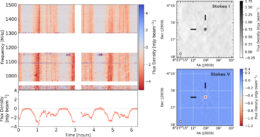Editor’s Note: In these last two weeks of 2023, we’ll be looking at a few selections that we haven’t yet discussed on AAS Nova from among the most-downloaded articles published in AAS journals this year. The usual posting schedule will resume in January.
Periodic Radio Emission from the T8 Dwarf WISE J062309.94–045624.6
Published July 2023
Main takeaway:

Observations of WISE J062309.94–045624.6 from the MeerKAT array. Click to enlarge. [Rose et al. 2023]
Why it’s interesting:
One of the many questions about brown dwarfs, which sit in the gap between the smallest stars and the largest planets, is the nature of their magnetic fields. The magnetic fields of stars and sub-stellar objects can be probed through their radio emission. Magnetic fields threaded through extremely hot coronal gas help to power radio emission from stars, but brown dwarfs are too cool to produce radio emission this way. Instead, their rapid rotation helps to generate currents that in turn create aurora-like radio emission.
Why more brown dwarf radio emissions are likely to be detected:
Brown dwarfs are faint at radio wavelengths, but their radio emission is expected to be strongly circularly polarized, making them stand out in surveys of circularly polarized radiation. WISE J062309.94–045624.6 was discovered through a search for strongly circularly polarized radio waves, and future searches with the exquisitely sensitive Square Kilometre Array (currently being constructed) should uncover even more — and even cooler — sources.
Citation
Kovi Rose et al 2023 ApJL 951 L43. doi:10.3847/2041-8213/ace188
